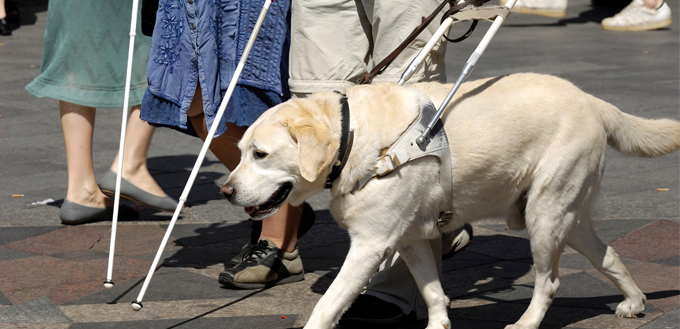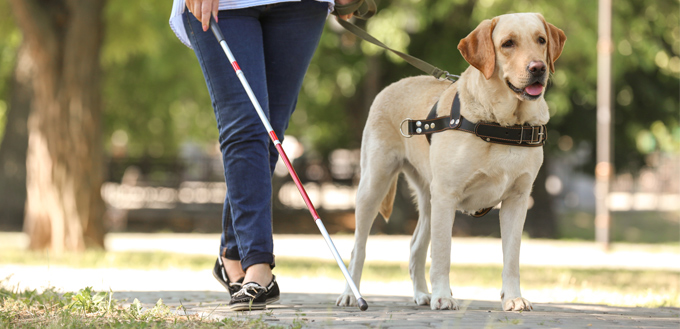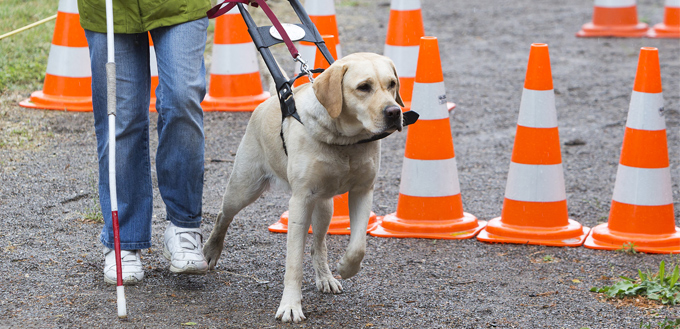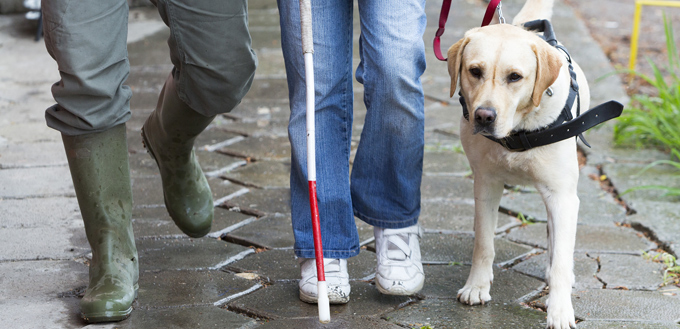Dogs are already a blessing from God. Among the blessed pool are our guide dogs! They are the answer to all our prayers – special dogs for special needs.
Many of us are familiar with the dog guiding other people who are visually disabled along parks, streets and other public places. However, if you have not actually benefited from these specially trained dogs, you have no idea how wonderful and loving companions they can be in reality.
Guide dogs are “mobility aids” for people who are blind or have less vision ability to travel safely. Guide dogs come with God gifted ability to escort people around and through obstacles and crowds. They are trained in such a way that some of them are able to recognize and find objects like chair, door and even the elevator. You see, what a grace they are!
So, today, our article is all about guide dogs and everything you need to know about them.

What do We Need to Know About Guide Dogs?
There are some common misconceptions about guide dogs. First and foremost: people think that blind people or visually impaired people don’t have a sense of orientation and mobility (O&M) travel skills due to which they prefer using a guide dog to travel independently and safely. In tune with that, people assume that the guide dog shows them the way.
This is not at all true. A person who is blind or visually impaired directs the dog, and the purpose of the dog is to merely lead the person around obstacles and show the location of curbs and steps.
Moving on to another misconception, which is that guide dogs show the person when it’s safe for them to cross the road. Again, not true. For instance, the guide dog has no idea when the signal light changes from red to amber to green. It’s the visually impaired person who determines whether it’s safe to cross the road and which way they should go. The guide dog just leads them across the road to reach to the other side safely.
Diversely, the guide dog doesn’t know whether it’s safe to cross the road or not. They see if cars are approaching from the other side and are too close. Note that the guide dog has been trained in a manner, whereby, he or she knows when to stop or attempt to move the person out of their way.
Is a Guide Dog Ideal for You?
If you think that you need a guide dog, you cannot just get one. There are steps to that, and thus you need to attend a special guide dog school. The school will appoint you a dog along with training you on how you must take care of the dog while he guides you all throughout your ways.
It is mandatory of guide dog schools to demonstrate to their applicants how they must have the necessary skills to travel independently with the dog. This usually includes walking safely, crossing roads, finding destinations and being able to find their way when lost or disoriented.
Be wary that guide dogs are not for everyone. You must consider two things at the back of your mind when thinking of getting a guide dog:
- High Maintenance
Guide dogs require daily care. They must be fed on time, appropriately groomed, provided with enough physical and mental stimulation, relieved and most importantly, given enough exercise and affection.
- Use Him or Lose Him
Guide dogs needs to be performed their mobility tasks each and every single day, without fail. Although they are scientifically bred as well as highly trained, the dog will lose his skills without continuous practice.
Where do They Come From?
Guide dogs graduate from guide schools. Yes, some institutes provide dogs with specific training programs in order to prepare them to help visually impaired people. These institutes are non-profit organizations or funded by charitable donations that specialize in training dogs with a handler. Normally, this includes:
- Breeding the guide dogs in an environmental condition
- Organizing puppy raising programs for future guide dogs
- Assessing prospective guide dogs
- Training guide dogs
- Training owners
- Training instructors
- Matching owners with their suitable dogs
- Taking responsibility for retired guide dogs by placing them in new homes
Golden retrievers, German shepherds and Labrador retrievers are what most schools prefer to train. That’s because these breeds are identified by their intelligence, stamina, obedience and friendliness and are therefore well suited for this job. Guide dog institutes breed their dogs in an extremely particular condition by choosing parents with intelligence and special guiding abilities.
Related Post: 8 Easiest Dog Breeds To Train
Even after paying such close attention to details, some puppies don’t turn out to be eligible for the job. In that case, those dogs are shifted to another organization, whereby they train dogs for other sorts of services like dogs helping people in wheelchairs. The rest of them are sold as pets. This is done with an agreement that later the dogs would be spayed or neutered to help control the dog population.
The Unique Abilities of Guide Dogs
Guide dogs are extremely smart! They not only learn how to guide a person safely around obstacles but are also trained in “intelligence disobedience”. Say, if a dog is given any unsafe cue from their cane, they are trained to disobey it, e.g. refuse to take a step forward into the road when there is oncoming traffic.
In addition to that, guide dogs are trained to obtain impeccable manners. For the times they will accompany you to a grocery store, public transportation or a restaurant, they will know how to avoid distractions. Guide dogs are natural born motivated creatures who have the eagerness to please and a strong willingness to work.
They take cues and direction from their human companions. It’s up to the person, who decides which route to take and whether it’s safe for them to cross the road. Through repetition, the guide dog knows how to remember their regular course. However, it is the person’s job to know their location at all times.

Is Having a Guide Dog like Having a Pet Dog?
Not really. A guide dog’s behavior in the house and a pet dog’s importance in the house is entirely different. While a guide dog should never be allowed to climb on furniture and sofas and should not be encouraged to get excited and bark when others arrive at your house. But of course, pet dogs are allowed to do that.
Always remember that your guide dog is your working dog and that his behavior will have an effect outdoors. Hence, it is your responsibility to maintain the dog’s training accordingly just so the dog responds correctly.
How are Guide Dogs Trained?
Here’s an overview of a guide dog’s life from puppy through retirement:
- Baby Steps
Just like we mentioned the guide dog institutions, who breed their own puppies in their own home, they are the ones who also train them. When such organizations breed their own dogs, they are able to ensure that their dogs have the best characteristics and temperament.
From an early age, the puppies are introduced to different types of environmental stimuli in the organization’s own controlled and secure way. This is to allow the puppy to develop specific coping skills and encourage him or her to gain better confidence.
To explain a bit about how their training begins, their litters are organized in alphabetical order. The puppies are given a name that starts with the litter’s alphabet.
- Home Socialization
When the puppies become about seven weeks old, they are put into volunteer homes as pairs for a week. Early socialization is all about overcoming obstacles like stairs and staying away from their mother and siblings.
- Early Learning
Once the puppies are done with their home socialization, and they step onto their eighth week, the puppy is assigned with a Volunteer Puppy Raiser, who educates them with house-training, basic obedience training and grooming. This education is the foundation for their future learning.
This is the essential socialization and training for the puppies to be confident and content in a different type of settings such as a busy town, or quiet roads, traveling on trains and buses and getting into elevators.
The puppy is also adjusted to situations where there is heavy traffic, loud noises, roadworks, church, behave well at restaurants and learning to deal with every situation.
- Off to School
At the age of 14 months, the dogs are sent to the training centers where they begin their early training. The initial training phase lasts for five months with an instructor.
At this point, if the dog qualifies the standards required to be a guide dog, the instructor then proceeds to an Advanced Training for the next three months. This is where the instructor improves the dog’s skills so that he can provide safe mobility for a blind or visually impaired person.
The instructor will observe the dog’s behavior, his personality traits; whether the dog is comfortable walking in the city or the countryside, whether the dog walks slow or fast, etc. Verifying such characteristics, the dog is then paired with someone on the waiting list who would meet the exact same requirements.
Matching the right dog to the right owner is crucial. Dog Guide centers put in a lot of time and effort to make sure that the best partnership is built.
- Out to Work
When the dog turns 22 months, he or she has finally graduated as a fully trained guide dog. Once the dog has been paired with their new owner, they both attend private classes together at the dog training center.
When the dog and owner go back to their home, instructors from the training center would still make visits to ensure that both the dog and the owner is working fine together.
- Retirement
Guide dogs usually tire when they are about 10 years old, and at this stage, the training center would look to retire the dog. Indeed, this is a very difficult time for both the owner and the dog, as they had spent about a decade together.
Although some owners would still prefer to keep the dog as their pet for the rest of their lives. However, if they don’t, there are always suitable homes for the dog. The owner is then replaced with a new guide dog as soon as the old one retires.

What do Guide Dogs do?
As you already know, guide dogs help visually impaired people to go around and help them with their mobility. However, a guide dog is trained to do a number of other things along with assisting the visually impaired person. They are:
- Walk in a straight line along the pavement while avoiding obstacles that appear on the route.
- Not to turn corners unless the owners ask them to do so.
- Stop at curbs and steps until asked to proceed.
- Find crossings, places and doors that they regularly visit.
- Assess height and width just so the owner doesn’t bump their head or shoulder.
- Deal with congestion.
- Guide the owner across the streets, although it’s them who decides when and where to cross safely.
- Keep on the route and ignore distractive like smells, people and other animals that may appear while walking.
- Bring the owner’s handler to the elevator buttons.
- Lie down and remain quiet when the owner’s handler is sitting down.
- Help the owner board buses and subways.
- Obey other verbal commands of the owner.
With giving all the commands and encouragement, the guide dog and the handler are both partners. The guide dog is not a miracle worker, rather a way for some people to offer an effective way to get around independently.
How to Get a Guide Dog?
Bear it in mind that applying for a guide dog is a huge step. It’s not about you or the dog anymore, it’s about fulfilling a partnership and adjusting to your goals, desires and lifestyles. Although you need to go through training classes, there are a few other steps of the application process too. Read ahead to find out about the application process:
Submit Your Application
Fill up a form with all your necessary details and submit it. Here’s the deal: some centers may prefer an online application, while others would require the form to be printed and mailed to their office. Make sure you follow the instructions given by the center just to avoid any misunderstandings.
Phone Consultation
Training centers do schedule a telephone consultation once they have received the application. That’s how they verify and review the application. Don’t get nervous about the telephone consultation; it’s more like a discussion. Some of it may even take about an hour as the training center talks about quite a few things such as:
- Your motivation for getting a guide dog
- Your goals, desires, lifestyles and travel practices
- Your health conditions
- How you travel independently so far without a guide dog
- You will also get the opportunity to ask questions and clarify any doubt. By the end of the conversation, you will figure out what other supplemental forms and documents are required to complete the application successfully.
Additional Forms
In addition to the application form, you may be asked to submit a few other forms which include:
- Your ophthalmologist’s report (required especially for first-time applicants)
- Physicians report that needs to be filled out by your primary health care physician, which may include a chest x-ray and a tuberculosis test report
- Orientation and mobility report
- Mental health report (required if you have seen or currently seeing any psychiatrist, counselor or psychologist)
Note: If you experience dealing with other guide dog schools, sometimes you may need to show a certificate or documents from them, too.
Home Visit
This is quite common. The guide dog center would schedule an appointment to visit the home where you currently reside. They will discuss this with you through the phone consultation. During their visit, the interviewer will assess a number of things like:
- Your ability to move about independently
- Your physical capability of working with a dog
- Your home environment and safety
- Your willingness to provide the best caring environment for the guide dog
- Any other additional factors that they feel contribute to the welfare of the dog
Approval Notification
When all the formalities have been completed, and the center have received all your forms and supplemental forms, they will notify you whether your application has been approved or not. Don’t worry, in most cases, it’s positive.
Class Scheduling
Upon acceptance, the guide school will contact you and schedule you a class date and the address of the campus location. Usually, an acceptance package along with the course materials are mailed to your house, so do check on your mailbox.
Class Begins
You arrive at the class and meet with your new furry partner and your exciting journey begin!
How do Guide Dogs Work?
If you feel that your guide dog must be tired or they must have gotten bored of their job, then we must say that you are wrong! Guide dogs love their job, and the satisfaction that they get from it is inexpressible. Games, praise, dog treats and helping their owner, that’s what they live for.
Even when the guide dog is not helping the handler, the dog is trained in such a way that they will ignore any distractions and sit still. That’s because the dog has been taught to behave at their owner’s workplace and any other public places without creating any disturbance.
When the guide dog is at his job, it is crucial that you understand that they are doing their job. Petting or any type of interaction with the dog breaks his concentration and impairs the owner’s ability to go around their surroundings. People are overwhelmed at the way guide dogs do their job, and thus they have a natural inclination towards praising them.
Related Post: Best Dog Leash
The best thing you could do is leave the guide dog alone so that it can pay attention to its surroundings and focus on its owners. Guiding can sometimes be a little complicated, and so it needs the dog’s undivided attention.
Guide dogs are aware of what they should do because they have something called selective disobedience. Guide dogs know how they should disobey commands that might put the owner in danger. They also know how to follow certain orders and depend on their own discernment of any situation.
Know that just like other dogs, guide dogs are color blind, too. So, in situations like crossing the street, the guide dog won’t know if the signal is red or green and will just go. The handler is the one who is to decide when it is safe and when they should go. The handler listens to the traffic and commands the dog “forward”. If there is a danger, the guide dog will not move forward until it is safe again.
Also, guide dogs are not aware of their handler’s destination. In that case, they follow the handler’s instructions on how far they should go and when to take a turn. The dog avoids any type of obstacles along the way, and the handler understands that there are obstacles. Surprisingly, guide dogs who have been with their owner for quite long can recognize some destinations. The owner just needs to command saying “go to the coffee shop” or “go to the office”, and the dog will know the route.
The most important rule for a guide dog is not to get distracted by anything. Even though the harness is on and the dog knows he’s at work, they must not be given any type of treats or petted unless the owner says it’s fine.
Related Post: Best Dog Harness
Things You Did Not Know About Guide Dogs:
Other than being fluffy, friendly and cute, guide dogs are almost irresistible to be played with. In fact, they are a lot more than just their sweet face. Guide dogs allow a visually impaired person with a life of freedom, companionship and mobility, which is nothing but awesome!
Here are some facts that we think you probably didn’t know about guide dogs:
- They come in different types of breeds
- Although they serve their owner loyally, it is not a one-way street
- They are whole-heartedly welcomed in public places
- They are not able to read traffic lights or any other colorful things as they are color blind
- Guide dogs retire when they need to
- Guide dogs love to play with other dogs
- They are guide dogs not guard dogs
- When guide dogs run on an errand, they are continually learning and training themselves

You may also like our article on the 10 Animals That Make The Best Office Pets.
Bottom Line
We are sure that other dogs envy guide dogs. And why wouldn’t they? Guide dogs are the ones who have the chance to go everywhere with their human companion, and they get showered with all the love and affection.
From work to school to restaurant to hiking trails and everywhere, they lead a very active life, which is probably the dream of every pet dog. When their harness is put on, they are in their “all business” mode. They are very serious about their work and focused on providing every safety for their handler. Just when the harness is off, it’s play time!
Related Post: Best Dog Lift Harness
Sources:
- Clinton R. Sanders, The Impact of Guide Dogs on the Identity of People with Visual Impairments, Taylor & Francis
- M.E.Goddard, Genetics Of Traits Which Determine The Suitability Of Dogs As Guide-dogs For The Blind, ScienceDirect







